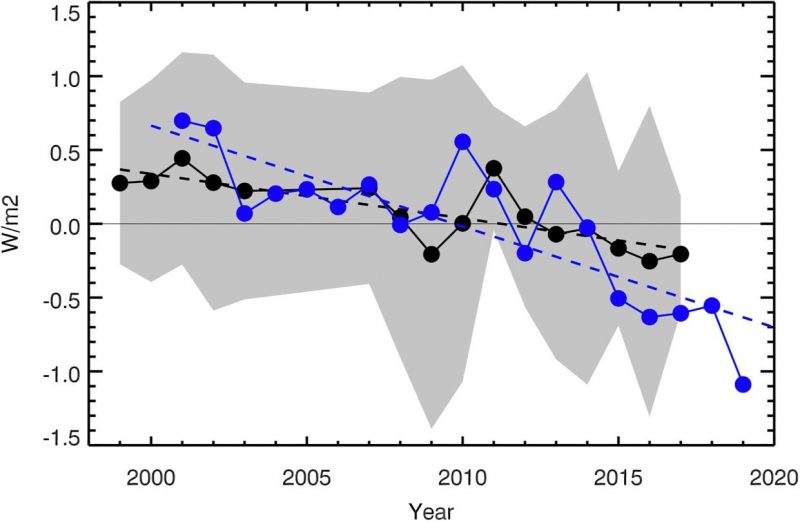
Earth is dimming
The American Geophysical Union (AGU) said on September 30, 2021, that Earth’s warming oceans are causing fewer bright clouds to reflect sunlight back into space. The result is that more heat reaches the Earth’s surface. The additional heat will, presumably, lead to even warmer oceans. This result is contrary to what many scientists had hoped. They’d hoped a warmer Earth might lead to more bright clouds and higher albedo (greater reflectivity), and more heat reflected away. That outcome would have helped to moderate warming and balance the climate system, they said. But their result shows the opposite is true.
The new Earth-albedo study is published in the peer-reviewed AGU journal Geophysical Research Letters.
These researchers used two decades of earthshine measurements and satellite measurements to quantify the drop in Earth’s albedo, or reflectance. Earthshine is what happens when sunlight bounces from Earth onto the night landscape of the moon (see the image at top). It’s that lovely dim glow you sometimes see on the darkened portion of a crescent moon. The Big Bear Solar Observatory in Southern California gathered the earthshine data from 1998 to 2017.
The scientists said that:
The Earth is now reflecting about half a watt less light per square meter than it was 20 years ago. Most of the drop has occurred in the last three years of earthshine data … It’s the equivalent of 0.5% decrease in the Earth’s reflectance. Earth reflects about 30% of the sunlight that shines on it.
It was a surprise
Philip Goode, a researcher at New Jersey Institute of Technology, is lead author of the new study. He said:
The albedo drop was such a surprise to us when we analyzed the last three years of data after 17 years of nearly flat albedo.
These scientists said that, when the latest data were added to the previous years, the dimming trend became clear. They said:
Two things affect the net sunlight reaching the Earth: the sun’s brightness and the planet’s reflectivity. The changes in Earth’s albedo observed by the researchers did not correlate with periodic changes in the sun’s brightness. So that means changes in Earth’s reflectiveness are caused by something on the Earth.
Specifically, there has been a reduction of bright, reflective low-lying clouds over the eastern Pacific Ocean in the most recent years. That’s according to satellite measurements made as part of NASA’s Clouds and the Earth’s Radiant Energy System (CERES) project.
That’s the same area, off the west coasts of North and South America, where increases in sea surface temperatures have been recorded. The increases are because of the reversal of a climatic condition called the Pacific Decadal Oscillation, with likely connections to global climate change.
The dimming of the Earth can also be seen in terms of how much more solar energy is being captured by Earth’s climate system. Once this significant additional solar energy is in Earth’s atmosphere and oceans, it may contribute to global warming. The extra sunlight is of the same magnitude as the total anthropogenic climate forcing over the last two decades.

Image via Goode et al. (2021)/ Geophysical Research Letters.
Inherent unknowns
So, in recent years, Earth has gotten dimmer, as climate has warmed. It’s an unexpected feedback and one that can be expected to warm Earth more. Is there any silver lining to this story of fewer bright clouds and a dimmer Earth? Maybe it’s that climate research has an inherent unpredictability, due to feedbacks precisely like this one. Maybe there’s some threshold of temperature increase, beyond which the clouds will brighten – and Earth as a whole will brighten – as Earth continues to warm? It’s possible … but cold comfort.
Bottom line: Scientists used measurements of earthshine, plus satellite data, to learn that Earth has dimmed significantly, especially in the study’s last three years.
Source: Earth’s Albedo 1998–2017 as Measured From Earthshine
The post Earth is dimming due to climate change first appeared on EarthSky.
from EarthSky https://ift.tt/3F9zgWH

Earth is dimming
The American Geophysical Union (AGU) said on September 30, 2021, that Earth’s warming oceans are causing fewer bright clouds to reflect sunlight back into space. The result is that more heat reaches the Earth’s surface. The additional heat will, presumably, lead to even warmer oceans. This result is contrary to what many scientists had hoped. They’d hoped a warmer Earth might lead to more bright clouds and higher albedo (greater reflectivity), and more heat reflected away. That outcome would have helped to moderate warming and balance the climate system, they said. But their result shows the opposite is true.
The new Earth-albedo study is published in the peer-reviewed AGU journal Geophysical Research Letters.
These researchers used two decades of earthshine measurements and satellite measurements to quantify the drop in Earth’s albedo, or reflectance. Earthshine is what happens when sunlight bounces from Earth onto the night landscape of the moon (see the image at top). It’s that lovely dim glow you sometimes see on the darkened portion of a crescent moon. The Big Bear Solar Observatory in Southern California gathered the earthshine data from 1998 to 2017.
The scientists said that:
The Earth is now reflecting about half a watt less light per square meter than it was 20 years ago. Most of the drop has occurred in the last three years of earthshine data … It’s the equivalent of 0.5% decrease in the Earth’s reflectance. Earth reflects about 30% of the sunlight that shines on it.
It was a surprise
Philip Goode, a researcher at New Jersey Institute of Technology, is lead author of the new study. He said:
The albedo drop was such a surprise to us when we analyzed the last three years of data after 17 years of nearly flat albedo.
These scientists said that, when the latest data were added to the previous years, the dimming trend became clear. They said:
Two things affect the net sunlight reaching the Earth: the sun’s brightness and the planet’s reflectivity. The changes in Earth’s albedo observed by the researchers did not correlate with periodic changes in the sun’s brightness. So that means changes in Earth’s reflectiveness are caused by something on the Earth.
Specifically, there has been a reduction of bright, reflective low-lying clouds over the eastern Pacific Ocean in the most recent years. That’s according to satellite measurements made as part of NASA’s Clouds and the Earth’s Radiant Energy System (CERES) project.
That’s the same area, off the west coasts of North and South America, where increases in sea surface temperatures have been recorded. The increases are because of the reversal of a climatic condition called the Pacific Decadal Oscillation, with likely connections to global climate change.
The dimming of the Earth can also be seen in terms of how much more solar energy is being captured by Earth’s climate system. Once this significant additional solar energy is in Earth’s atmosphere and oceans, it may contribute to global warming. The extra sunlight is of the same magnitude as the total anthropogenic climate forcing over the last two decades.

Image via Goode et al. (2021)/ Geophysical Research Letters.
Inherent unknowns
So, in recent years, Earth has gotten dimmer, as climate has warmed. It’s an unexpected feedback and one that can be expected to warm Earth more. Is there any silver lining to this story of fewer bright clouds and a dimmer Earth? Maybe it’s that climate research has an inherent unpredictability, due to feedbacks precisely like this one. Maybe there’s some threshold of temperature increase, beyond which the clouds will brighten – and Earth as a whole will brighten – as Earth continues to warm? It’s possible … but cold comfort.
Bottom line: Scientists used measurements of earthshine, plus satellite data, to learn that Earth has dimmed significantly, especially in the study’s last three years.
Source: Earth’s Albedo 1998–2017 as Measured From Earthshine
The post Earth is dimming due to climate change first appeared on EarthSky.
from EarthSky https://ift.tt/3F9zgWH

Aucun commentaire:
Enregistrer un commentaire